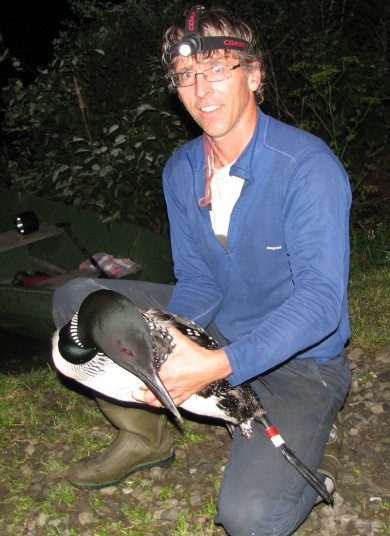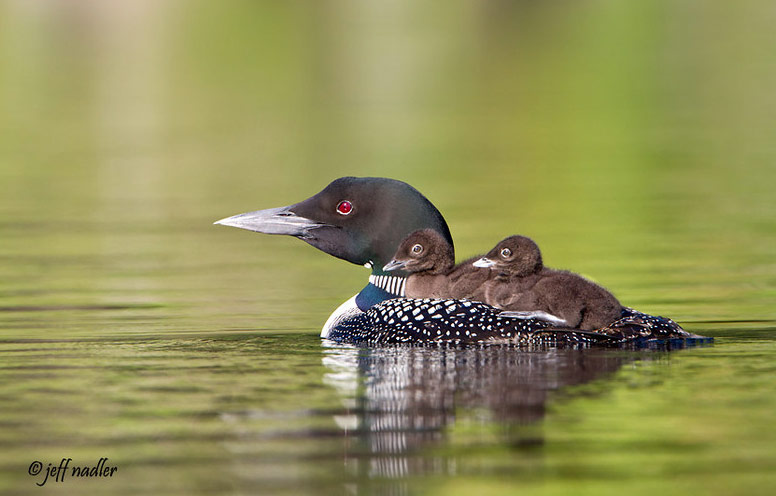
VCE Loon Biologist Eric Hanson is ready to release a loon after it was disentangled from fishing line. / © Melissa Perley
This year marks two decadal anniversaries: the 40th year of the Vermont Loon Conservation Project (VLCP) and my 20th year coordinating that core VCE program. Twenty years ago, I drove up to Island Pond for the first time in early May to meet with former loon biologist Sally Borden for breakfast at the Clyde River Restaurant. Sally had coordinated VLCP for three very successful years, overseeing development of the formal Vermont Loon Recovery Plan. We went over lake lists, volunteer lists, and logistics of rafts and signs. I’d never before seen either a loon nesting raft or a nest warning sign! I’d spent the previous five years observing, studying, and capturing loons, so I had some pretty extensive knowledge, but rafts and signs were seldom used in Minnesota or Wisconsin, where I’d conducted most of my work. This meeting launched my 20-year trajectory — it has been a truly amazing journey to foster VLCP watching the statewide loon population grow from 106 adults on Loonwatch day in 1998 to 308 in 2017, and numbers of nesting pairs jump from 25 to 97 during that same period. I should note that Sally is still involved with Vermont loons in the Lake Dunmore area and now has two wonderful daughters, who accompany her in the field!
Jumping ahead 20 years, several weeks ago, I finally met loon volunteer George Barbash for the first time. “Barbash” is a name I’d known for 20 years. He was on the original Loonwatch volunteer list Sally gave me as the person who routinely trekked a mile up to remote Wallingford Pond on U.S. Forest Service land. Finally, after sending George letters for 10 years, and then emails for another decade, I actually met the man. He is an unassuming contractor who likes walking in the woods, does his own thing, and calls it good. No need to ask for anything. His notes read like: “nest located in the east bay this year“, “lost the chicks”, “failed nest”, “two chicks made it again”, etc. There are numerous other volunteers who have been around even longer than me, and I truly thank each of you for your years of assistance and dedication: Stan Dunklee and Judy Robitaille (on Crystal Lake, with daughter and Olympic biathlete Susan Dunklee, who mentored with me for a day back in high school), Ann Creaven (Glover area), Mary Daly (Martins Pond), Jonathon Doyle-Schetman (Long Pond), Judy Dunnan (Coles Pond), Janet Dyer (Island Pond), Alice Fleer (Shadow Lake), Tom Fetter (Holland Pond), Cathy Murphy and John Gailmor (Hardwood Pond), Sally and Dave Lafoe (Norton Pond), Pat Gorman and Rhonda Bohovich (Spectacle Pond), Alicia Hingston (Barnet area ), Maeve Kim (many places), Linda McElvany (Colchester Pond), Stan Swaim (lots of lakes), Adam Parke (May P.), Mitzi Queen (Halls Lake), Pete Rodin (Little Averill Lake), Lin Mixer and Lee and Mary Stewart (Maidstone Lake), Darlene Sprague (Lake Groton), the Stowe family (Fosters Pond), Rollin Tebbets (Mollys Falls Res.), George Wilcox (Island Pond), Sue Wetmore (west central VT), Charles Woods (Lake Seymour), and likely several others who I’m inadvertently missing here.
I now have over 1,000 names on our loon volunteer contact list, of which about 300 are currently active. Some of these folks are people who once reported a loon caught up in fishing line, and I’ve never heard from again. Others are out there every week taking care of nesting rafts and signs, and annually reporting to their lake association. It’s a great thing about how this project works — you can do as little or as much as you like, you can take five years off to travel to Timbuktu, then come back and watch (and report on) your birds. They’re likely the same ones that were there when you left!
All of these people epitomize what the Vermont Loon Conservation Project is — a community of dedicated individuals who harbor a deep love for their lakes, the woods, and these black-and-white birds. So, a heartfelt thank you to all the people — all of you — who make the VLCP go. Thank you for sharing your stories and teaching me about the many wondrous things that loons bring to all of us.

